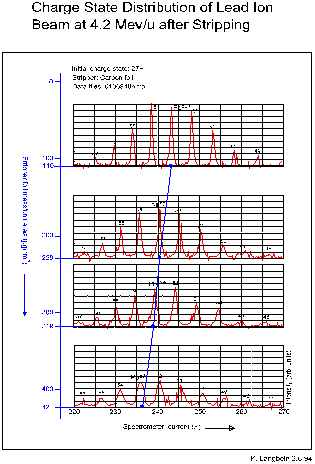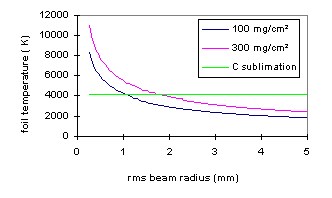The new CERN Heavy Ion Linac (Linac3) accelerates a Pb27+ beam to 4.2 MeV/u. The beam is then stripped to Pb53+ by a carbon foil, and, after stripping, a 12 m filter line prepares the beam for the injection into the Proton Synchrotron Booster (PSB). The filter line eliminates the unwanted charge states, checks the beam quality (energy, energy spread, transverse emittance and intensity), and finally transports the beam in the lines leading to the PSB.
The paper summarises the transverse beam dynamics
of the line, and reports on its commissioning, especially focusing
on the experiments that led to the stripper choice, and on the
measurements performed with a specially developed single pulse
multislit emittance device. The operational experience is also
reported.
At the end of Linac3, the Pb27+ ions are stripped to obtain a beam with a magnetic rigidity of 1.16 Tm, only 16% higher than the 50 MeV protons, which have in common with the ions (on pulse-to-pulse basis) the long transfer line and the injection into the PSB. This allows the use of the same magnetic elements for both particles. Optimum charge state and energy giving the required rigidity after stripping from Pb27+ have been determined as Pb53+ at 4.2 MeV/u [1].
A filter-stripper line (see Fig.1), 12 meters long, between the end of the linac and the shielding wall that separates Linac3 from the transport line to the PSB, is used to select and optimise for injection into the PSB the desired charge state after stripping, and to measure the parameters of the different lead ion beams (27+ and 53+ with the adjacent charge states). Measurements have to be performed independently from PSB operation, and on single pulse basis, to observe the ion beam stability. The design and realisation of the line has been done at CERN in collaboration with the INFN-Torino [2].
After the linac interdigital-H tanks, a quadrupole
triplet focuses the beam on the stripper, then a four bending
magnet sequence eliminates the unwanted charge states on a slit.
At the end of the line, a debunching cavity (made at IAP-Frankfurt)
minimises the energy spread for injection into the PSB. Longitudinal
beam parameters are measured at the exit of the linac by a Bunch
Length and Velocity Detector (BLVD), made at INP-Moscow [3], and
by using the first bending magnet as a spectrometer. Horizontal
and vertical emittances
are measured in a straight line after the first bend with a single
pulse emittance measurement device of the multislit type [4].
Five SEM-grids at different positions in the line allow the measurement
of the horizontal and vertical beam position and profile, and
two phase probes check the phase profile. Finally, beam currents
for the different charge states are measured with two transformers,
placed before and after the slit.

The optics of the line have to take care of some
critical points. First of all, position and transverse size of
the beam should not exceed the foil dimensions (20 mm diameter)
in the 100 mm long longitudinal region where the four stripper
supports are located. Then, the filter resolution has to be considered,
because the transverse width of the beam spot at the slit has
to be smaller than the distance between two adjacent charge states.
Moreover, the four bending magnets have to form an achromatic
system with minimum emittance increase. The matching, done with
the code TRACE-3D [5], is shown in Fig.2. It takes into account
the emittance increase at the stripper, as well as the change
of charge state.

The first stripping tests were done with carbon foils of surface density 100, 200, 300 and 400 g/cm2. Fig. 3 shows the corresponding charge state distributions measured after the spectrometer. They are all centred around 53+, in excellent agreement with the predictions of Baron's formula[6].
This indicates that the equilibrium thickness is
already reached with the 100 g/cm2 foils. Straggling
is responsible for the larger energy spread across thicker foils.
For Pb53+ and a 100 g/cm2 foil we measured
an increase in energy spread of 11% (±33 against ±30
keV/u (2)) after stripping. This is acceptable for beam transport,
since the energy spread for PSB injection is mainly defined by
the debunching cavity. Therefore 100 g/cm2 (thickness
of 0.5m) has been kept as the nominal stripper surface density.
The beam energy loss across this foil, measured at the spectrometer,
is W = (130 10) keV/u, in good agreement with the Firsov formula
[7].

The increase in beam divergence inside the stripper
foil leads to an emittance growth that has been evaluated by measuring
the increase in beam size at the SEM-grid after the stripper position,
first without stripper, and then with two foils of increasing
surface density. The measured data have been linearly fitted to
the beam size calculated by TRACE-3D, taking as first input to
the code the emittance and the Twiss parameters measured without
the foil, and then emittances with increasing divergence at the
stripper position. The result was a / = (6 2) % for the nominal
stripper thickness, larger than calculated, but smaller than the
10% foreseen in the design report [1].
Since the first experiments, we noticed that foils
thicker than 200 g/cm2 broke down after only a few
minutes. For the 100 g/cm2 foils, direct observations
through a quartz window showed that increasing the focusing on
the stripper made the beam visible on the foil as a red spot.
As the focusing was further increased the spot turned white and
the foil broke. These observations can be explained by a calculation
of the temperature T reached by the foil during the beam
pulse. The energy that the beam loses inside the foil, as consequence
of scattering with the foil atoms, goes first to heating of the
foil material (only about 0.1% goes to the stripping of electrons),
and then is dissipated by radiation from the small beam spot on
the foil, the conductivity contribution through the 0.5 m thickness
being negligible. We can represent the three contributions with
the equation:
i.e. the power produced by a beam of current I
that loses the energy W is equal to the sum of the increase
in thermal energy of the stripper material (mc being its
mass and specific heat) and of the radiated power, expressed by
the Stefan-Boltzmann relation for the emission from a surface
S. is the emissivity (0.75 for Carbon) and the Stefan-Boltzmann
constant. The factor 2 takes into account the fact that energy
is radiated from both sides of the foil. After a time usually
shorter than the beam pulse length, T converges to the
equilibrium temperature (T0 can be neglected
if T»T0):
 (1).
(1).
The highest temperature is reached at the centre
of the beam distribution, where the current density dI/dS
is maximum. Considering a gaussian beam distribution in the transverse
plane, dI/dS converges to I/2xy, with I the
total beam current and x,y the rms dimensions of the beam.
Introducing this value into (1), one obtains the maximum stripper
temperature as:
 (2).
(2).Taking the Linac3 beam parameters, 80 A of Pb27+ and 130 keV/u energy loss, for a round beam of rms radius rrms we obtain the temperature as function of beam radius of Fig. 4. TRACE-3D calculations give rrms=1.6mm, indicating that the temperature of the stripper of 100 g/cm2 comes close to the temperature of Carbon sublimation, 4100 K, assumed as the maximum that the foil can stand. Small reductions in beam size or imperfections in the foil would break it, while only a small increase in beam size brings the temperature down to a safe value. Since the energy loss W is proportional to the foil thickness, thicker foils reach higher temperatures. The colours observed on the foil before breaking correspond well to the peak emission wavelength at the calculated temperatures. In conclusion, one has to find a compromise between the lifetime of the foil, requiring a large beam size, and the minimisation of the emittance growth due to the increase in divergence, that instead requires a small beam size. This compromise has been found easily at Linac3 since emittance growth is not a very critical issue (large PSB acceptance), and foil lifetimes are now of the order of 2/3 months.
The formula (2), with the needed changes in the parameters, indicates as well that an Al2O3 stripper (melting T=2345 K, =0.2), considered as an alternative to Carbon because it is easier to produce and more homogeneous in thickness, would not withstand the temperatures induced by the Linac3 beam.

A single pulse emittance measuring device was required to check the pulse to pulse stability of the linac. We choose a multislit plate with a scintillator screen and CCD camera readout. Particles traversing the slits produce light on the scintillator and a special triggered CCD camera captures and digitises the image every 1.2sec, the repetition rate of the linac. Special software reconstructs the emittance from the digitised image and calculates the Twiss parameters [4].
Starting from nominal emittance values and orientations, preliminary simulations were needed to transport the beam to the multislit (see Fig.1). Final adjustments, especially with the steerers, were made by working experience.
CCDs' saturation was avoided using a fast exposure time (150 s) and stopping down the iris. The scintillator, a CERN Cromox type 6 Al2O3 + 0.2% Cr2O3, showed linearity in our beam current range (up to 80 A of Pb27+ ) and no substantial degradation in performances in 30 hours operational time.
To obtain the Twiss parameters at Linac3 output we
made backward TRACE-3D simulations taking as input the values
measured at the detector and as output the Linac output parameters.
We checked the measurement with different optics, confirming both
the reliability of the device and the good pulse to pulse stability
of the Linac. The multislit plate with 4 mm slit spacing and 0.2
mm slit width is a good compromise to obtain the best resolution.

An emittance plot at the detector position is shown
in Fig. 5 and a summary of the measured values for Pb27+
is in Table 1. Measurements for Pb53+ are not very
precise, since the detector is placed before the ion separation,
nevertheless the total (4 x rms) horizontal emittance after stripping
has been estimated to be ~10.5 mm mrad.
| x/ (unnorm.)
mm mrad | y/ (unnorm.)
mm mrad | W
[keV], 2 |
| 9.7 | 9.9 | ±30 |
Table 1: Measured beam parameters at Linac3 output
(Pb 27+).
The matching of the line and the stripping were easier
than foreseen, the best results being obtained with a 100g/cm2
carbon foil. The current transmission of the line is almost 100%
(max. 80 A of Pb53+ ), and the beam quality is good
for the injection to the PS Booster. The linac shows an excellent
pulse-to-pulse stability.
Our thanks go to C.Dutriat, L.Bernard, G.Martini and G.Molinari for their continuous assistance during the commissioning, to J.M.Quesada who provided us with some theoretical background and to K.Langbein for helping during measurements.
This paper is dedicated to the unforgettable P.Têtu.
His legacy of scientific and human experience was essential to
accomplish successfully the work that he had started.
[1] D.Warner (ed.), "CERN Heavy Ion Facility Design Report", CERN 93-01 (1993).
[2] P.Têtu, "Linac à plomb: zone de mesure, filtrage, transfer à 4.2 MeV/nu", CERN PS/HI Note 90-03 (1990).
[3] Y.Bylinsky, A.Feschenko, A.Liiou, A.Men'shov, P.Ostroumov, H.Kugler, D.J.Williams, "Bunch Length and Velocity Detector and its Application in the CERN Heavy Ion Linac", Proc. of the 4th EPAC Conference, London, 1994, p.1702.
[4] M.Crescenti, U.Raich, "A Single Pulse Beam Emittance Measurement for the CERN Heavy Ion Linac", CERN/PS/95-46 (HI) (1995).
[5] K.R.Crandall, "TRACE-3D Documentation", Los Alamos Accelerator Code Group, LA-UR-904146.
[6]E. Baron, GANIL Report 79R/146/TF14.
[7] O.B.Firsov, Sov. Phys.- JETP, 9 (1959) 1076.